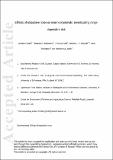Files in this item
Effects of impulsive noise on marine mammals : investigating range-dependent risk
Item metadata
| dc.contributor.author | Hastie, Gordon | |
| dc.contributor.author | Merchant, Nathan | |
| dc.contributor.author | Goetz, Thomas | |
| dc.contributor.author | Russell, Debbie J. F. | |
| dc.contributor.author | Thompson, Paul | |
| dc.contributor.author | Janik, Vincent M. | |
| dc.date.accessioned | 2019-06-13T12:30:08Z | |
| dc.date.available | 2019-06-13T12:30:08Z | |
| dc.date.issued | 2019-07 | |
| dc.identifier | 258358601 | |
| dc.identifier | b7532ebd-c92d-45c9-b0ca-dd7e866770a8 | |
| dc.identifier | 85068229053 | |
| dc.identifier | 000474485400002 | |
| dc.identifier.citation | Hastie , G , Merchant , N , Goetz , T , Russell , D J F , Thompson , P & Janik , V M 2019 , ' Effects of impulsive noise on marine mammals : investigating range-dependent risk ' , Ecological Applications , vol. 29 , no. 5 , e01906 . https://doi.org/10.1002/eap.1906 | en |
| dc.identifier.issn | 1051-0761 | |
| dc.identifier.other | ORCID: /0000-0002-1969-102X/work/58531578 | |
| dc.identifier.other | ORCID: /0000-0002-9773-2755/work/58531616 | |
| dc.identifier.other | ORCID: /0000-0001-7894-0121/work/60427873 | |
| dc.identifier.other | ORCID: /0000-0002-4630-3328/work/71221496 | |
| dc.identifier.uri | https://hdl.handle.net/10023/17882 | |
| dc.description | This work was funded as part of the Department of Energy and Climate Change’s Offshore Energy Strategic Environmental Assessment programme, with additional resources from the National Capability funding from the Natural Environment Research Council to the Sea Mammal Research Unit (grant no. SMRU1001). | en |
| dc.description.abstract | Concerns exist about the impacts of underwater noise on marine mammals. These include auditory damage, which is a significant risk for marine mammals exposed to impulsive sounds such as explosions, pile‐driving, and seismic air guns. Currently, impact assessments use different risk criteria for impulsive and non‐impulsive sounds (e.g., ships, drilling). However, as impulsive sounds dissipate through the environment, they potentially lose hazardous features (e.g., sudden onset) and become non‐impulsive at some distance from the source. Despite management implications, a lack of data on range‐dependent characteristics currently limits their inclusion in impact assessments. We address this using acoustic recordings of seismic air guns and pile‐driving to quantify range dependency in impulsive characteristics using four criteria: (1) rise time < 25 ms; (2) quotient of peak pressure and pulse duration > 5,000 Pa/s; (3) duration < 1 s; (4) crest factor > 15 dB. We demonstrate that some characteristics changed markedly within ranges of ~10 km, and that the mean probability of exceeding criteria 1 and 2 was <0.5 at ranges >3.5 km. In contrast, the mean probability of exceeding criteria 3 remained >0.5 up to ~37.0 km, and the mean probability of exceeding criteria 4 remained <0.5 throughout the range. These results suggest that a proportion of the recorded signals should be defined as impulsive based on each of the criteria, and that some of the criteria change markedly as a result of propagation. However, the impulsive nature of a sound is likely to be a complex interaction of all these criteria, and many other unrelated parameters such as duty cycle, recovery periods, and sound levels will also strongly affect the risk of hearing damage. We recommend future auditory damage studies and impact assessments explicitly consider the ranges at which sounds may lose some of their potentially hazardous characteristics. | |
| dc.format.extent | 10 | |
| dc.format.extent | 442782 | |
| dc.language.iso | eng | |
| dc.relation.ispartof | Ecological Applications | en |
| dc.subject | Auditory damage | en |
| dc.subject | Marine animals | en |
| dc.subject | Pile driving | en |
| dc.subject | Seismic survey | en |
| dc.subject | Sound propagation | en |
| dc.subject | Underwater noise | en |
| dc.subject | GC Oceanography | en |
| dc.subject | QH301 Biology | en |
| dc.subject | DAS | en |
| dc.subject | SDG 14 - Life Below Water | en |
| dc.subject.lcc | GC | en |
| dc.subject.lcc | QH301 | en |
| dc.title | Effects of impulsive noise on marine mammals : investigating range-dependent risk | en |
| dc.type | Journal article | en |
| dc.contributor.institution | University of St Andrews. Sea Mammal Research Unit | en |
| dc.contributor.institution | University of St Andrews. School of Biology | en |
| dc.contributor.institution | University of St Andrews. Scottish Oceans Institute | en |
| dc.contributor.institution | University of St Andrews. Marine Alliance for Science & Technology Scotland | en |
| dc.contributor.institution | University of St Andrews. Centre for Research into Ecological & Environmental Modelling | en |
| dc.contributor.institution | University of St Andrews. Institute of Behavioural and Neural Sciences | en |
| dc.contributor.institution | University of St Andrews. Centre for Social Learning & Cognitive Evolution | en |
| dc.contributor.institution | University of St Andrews. Bioacoustics group | en |
| dc.identifier.doi | https://doi.org/10.1002/eap.1906 | |
| dc.description.status | Peer reviewed | en |
| dc.date.embargoedUntil | 2019-06-12 |
This item appears in the following Collection(s)
Items in the St Andrews Research Repository are protected by copyright, with all rights reserved, unless otherwise indicated.

